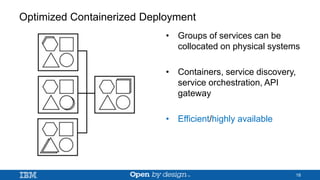Building next gen applications and microservices
- 1. Building Next Gen Applications and Microservices Manuel Silveyra, IBM Open Technologies @manuel_silveyra May 25, 2016
- 2. IBM Swift Package Catalog 2 https://swiftpkgs.ng.bluemix.net/
- 4. 1. From Heavyweight Development to Agile 4 • A consolidation of ideas from Extreme Programming, Scrum, Lean, etc. • Tried to remove the overhead and risk of large scale software development by having: – Smaller work increments – Frequent iterations – Rapid prototyping Continuous Integration Agile Heavyweight development Continuous Deployment DevOps Microservices
- 5. 2. From Agile to Continuous Integration (CI) 5 • Sought to combine software components as early in the lifecycle as possible in order to minimize the impact of code integration issues. • Virtualization and automated testing removed technological barriers to CI. • The adoption of Agile led to a growth in CI, which was a common practice in Extreme Programming. Continuous Integration Agile Heavyweight development Continuous Deployment DevOps Microservices
- 6. 3. From CI to Continuous Delivery (CD) 6 • CD defines a deployment pipeline to bring changes to production as quickly as possible. • Is an instantiation of Scrum’s “potentially shippable product increment”. Continuous Integration Agile Heavyweight development Continuous Deployment DevOps Microservices
- 7. 4. From CD to DevOps 7 • In most organizations development and operations were separate. • Organizations where operations and development were together were more successful at establishing CD practices. • Engineering approaches were taken to problems that were previously dealt with procedurally. • This led to: – Higher automation in day to day tasks – Greater stability and resilience Continuous Integration Agile Heavyweight development Continuous Deployment DevOps Microservices
- 8. 5. From DevOps to Microservices 8 • The architectural phase where large monolithic applications are broken down into discrete, business focused services. • This led to: – Higher development parallelization – Greater scalability and utilization Continuous Integration Agile Heavyweight development Continuous Deployment DevOps Microservices
- 9. Microservice Outcomes • Increase Speed • Reduce Cost • Improve Resilience • Enable Visibility 9
- 10. Microservice Keys to Success 10 Architecture MethodologyTechnology Organization
- 11. Organizational Success • Are teams aligned to business or technology? • How are responsibilities divided between teams? • At what level of organization are development and operations divided? DevOps or Development and Operations? • What are team sizes and skills? • Dependencies and cross-team communications? • Power distribution between teams? 11 Architecture MethodologyTechnology Organization
- 12. Methodological Success • Product or projects? • Agile or waterfall? • Who controls business requirements? • Fear of change, or continuous delivery? • Degree of automation in deployment and operations? 12 Architecture MethodologyTechnology Organization
- 13. Technological Success • Cloud provisioning? • Virtualization? Containerization? • Application integration approach? • Security and identity management? • Operational middleware? • Language? Databases? • Legacy technologies? 13 Architecture MethodologyTechnology Organization
- 15. Microservice Technologies • Containers – Encapsulate services and are accessible by IP/port combination • Service Discovery – Provides a way to know when services have been added/removed and where they are located • Service Orchestration – Manages service topologies – Ensures availability and utilization • API gateway – Security – Routing 15
- 16. High Level View • Connect to services through HTTP • Services communicate through event bus • Services can be written in whatever language is best for the task and skills available • Each service stores data independently 16
- 17. Containerized Deployment • Services can scale independently according to load without affecting the others • Services connect to external data stores (databases, BLOB stores, etc.) • Containers, service discovery, API gateway • Efficient/single point of failure 17
- 18. Optimized Containerized Deployment • Groups of services can be collocated on physical systems • Containers, service discovery, service orchestration, API gateway • Efficient/highly available 18
- 19. Microservice Principles • Do One Thing Well • Build Afresh • Expect Output to Become Input • Don’t Insist on Interactive Input • Try Early • Don’t Hesitate to Throw it Away • Toolmaking 19
- 20. 20




















